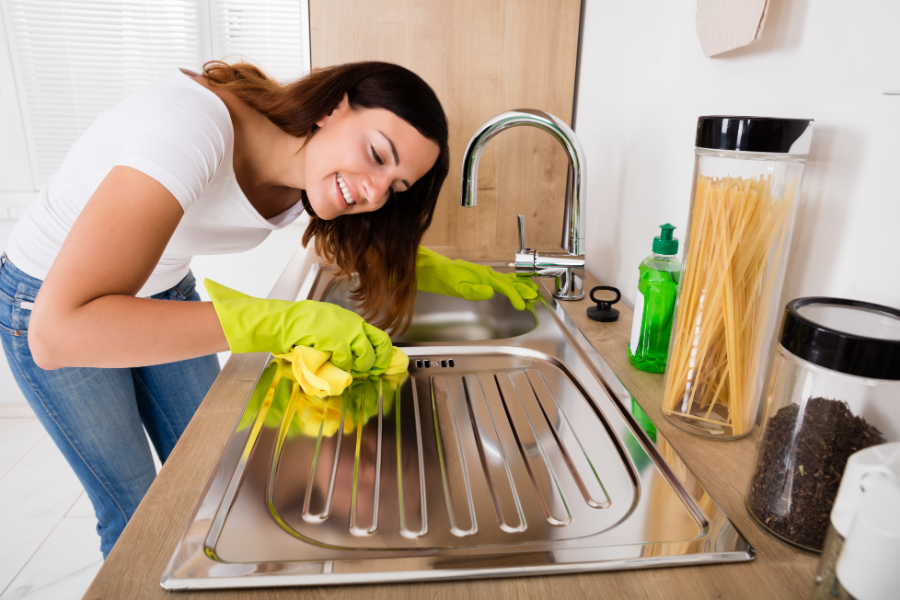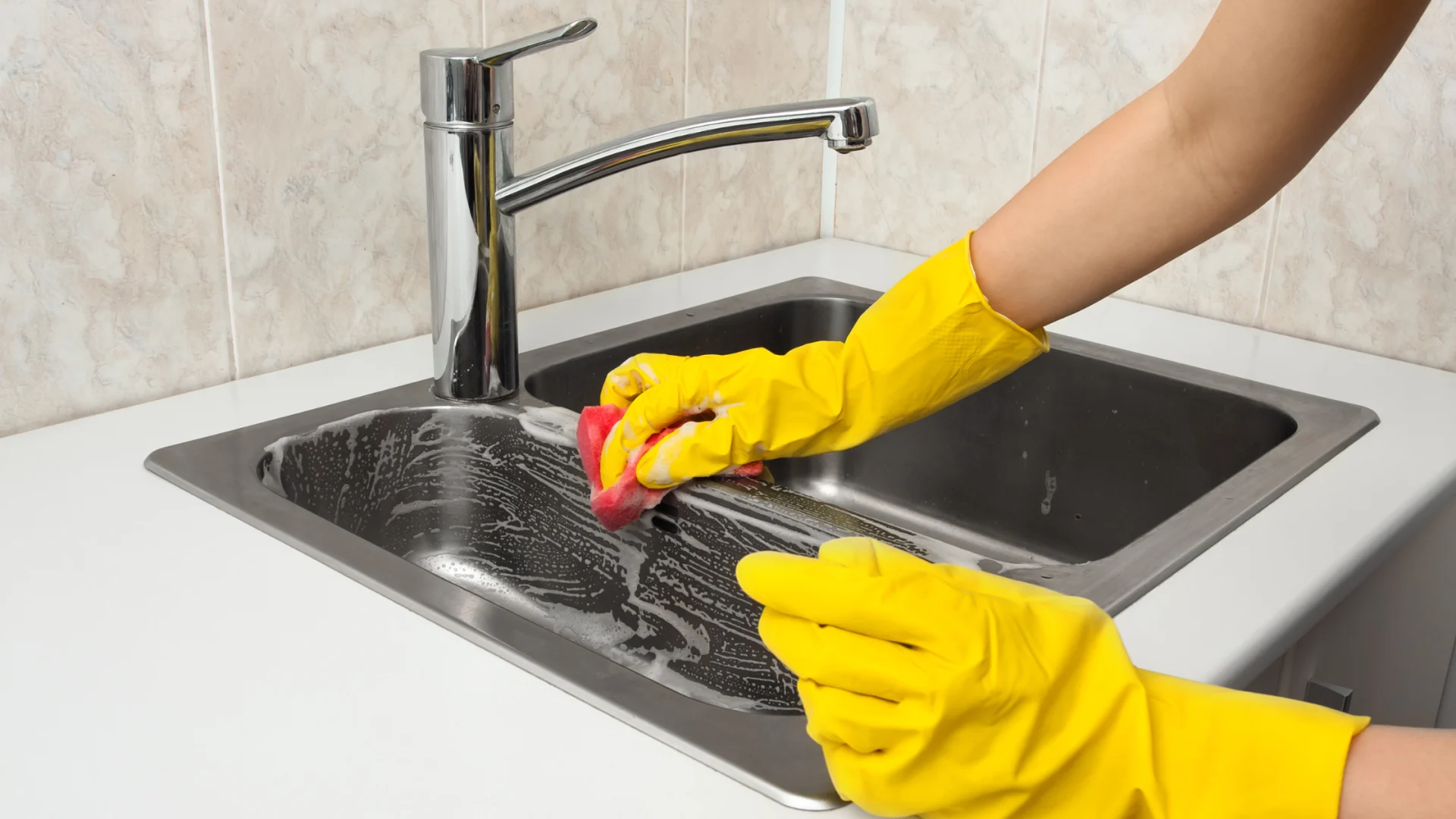Have you ever used a natural stainless steel sink cleaner? In most homes, the kitchen is always one of the first areas to get dirty and messy, especially if you have a stainless-steel sink. If you cook regularly, the sink will usually accumulate layers of dirt or grime. But keeping your stainless steel sink bright and shiny using a natural stainless steel sink cleaner is easier than you think.
More often than not, everything you need to keep your stainless steel sink clean is lying around your home. And non-toxic, making using these products safe for everyone in the house.
So, how can you keep your stainless steel sink looking new, shiny, and cleaner? Fret not! Follow this natural and non-toxic guide that avoids using harsh chemicals to polish your stainless steel sink.
What is the Best Household Product to Clean a Stainless Steel Sink?
If we are going to choose one specific natural cleaning product to clean a stainless steel sink, it should be vinegar. Vinegar is a cure-all for many household cleaning issues. It is efficient, widely available, and, most of all, affordable.
If you add vinegar to the sink, it can deodorize the sink and eat away bacteria. The longer you allow it to sit, the more it can wipe away dirt, clean the drain, and make the sink smell better.
Baking Soda is another fantastic, versatile natural cleaning product. As a base, it dissolves organic materials and deodorizes rancid smells. And together, they are a natural and powerful combo for cleaning a stainless steel sink. However, you’re not limited to these natural household products to achieve a much cleaner sink.
Baking soda and vinegar don’t only clean stainless steel sinks, together they can unclog and clean drains. Read our article – How to Use Baking Soda and Vinegar to Clean a Drain to learn how.
Natural Household Stainless Steel Sink Cleaners
Here are other natural methods to help you clean your stainless steel sink:
Ice and Salt
To prevent using bleach or borax, use ice and salt instead. Ice can help remove dirt or debris from your stainless steel sink, which is the root cause of bad smells. Salt, however, can remove dirt easily.
Ice and Lemon
Like vinegar and baking soda, lemon is a natural deodorizer. Adding ice lets you easily clean the drain and make the sink smell good. You can also use lemon by itself to clean the sink. Like vinegar, the acidity of lemon cleans the stainless steel and makes it shine.
Club Soda
Club soda helps keep the stainless steel sink looking shiny. Pour the club soda into a spray bottle and spray it all over the sink. Be sure to wipe the sink with a terry cloth.
Flour
Perhaps you have flour at home. You can use it to keep the stainless steel looking fresh and shiny. Just sprinkle the flour over the sink and scrub it. Once done, don’t rinse the flour, as it can cause clogging problems in the drain. Wipe the flour out of the sink, then rinse it.
Alternative Stainless Steel Sink Cleaners
Although microfiber cloths aren’t natural, they are non-toxic and eco-friendly. Specially made stainless steel microfiber clothes are very effective and easy to use when cleaning stainless steel sinks and other stainless steel things.
How to Clean Stainless Steel Sink Properly
While you can use a commercial cleaner to clean your stainless steel sink, we want to let you know that you don’t need to use or buy them to keep the sink clean. As mentioned, most things you need are already available in your pantry or cupboards.
There is nothing better than natural products like vinegar and baking soda. These items combined create a powerful cleaning tool. Here’s a step-by-step guide to cleaning your stainless steel sink properly:
Things you’ll need:
- Vinegar
- Baking Soda
- Dish Soap
- Cream of tartar (optional)
- Non-Scratch Scrub sponge
- Spray bottle
- Microfiber Cloth
Instructions
- Rinse the sink with hot water to eliminate scraps or bits of food. Use dish soap if dirt is difficult to remove.
- Sprinkle the baking soda all over the sink. Baking soda helps neutralize the odor of the sink and clean its surfaces without you marring or scratching the stainless steel.
- Scrub the stainless-steel sink with a non-scratch scrub sponge. You can use nylon or a scrubbing brush to effectively scrub the sink, as long as it is not too abrasive.
- Add the vinegar to a spray bottle and spray it around the sink. Allow the baking soda and vinegar mixture to work in the sink. Vinegar is ideal for removing calcium-based spots, all thanks to its natural acidity.
- If there are tough stains, you can treat them by mixing vinegar and cream of tartar.
- Now you’re done! Rinse the stainless-steel sink with water and dry it with a terry cloth.
How to Make Stainless Steel Sink Shine (Bonus Step)
Okay, this hack isn’t necessary, but it effectively leaves your stainless-steel sink looking fabulous.
After you have followed the guide above, put a few drops of olive oil on a clean cloth and buff the sink until it’s gorgeous and gleaming. Don’t use too much olive oil, though, as it can make the sink greasy.
How Often Should You Clean a Stainless Steel Sink?
If you want to keep your stainless steel sink clean, clean it regularly after using it for the day. However, deep clean the sink at least once a week.
Random Tips to Make a Natural Stainless Sink Cleaner

Luckily, there are some ways to make the chore of cleaning stainless steel sinks easier, more enjoyable, and less messy.
Wear Rubber Gloves
Wear rubber gloves when cleaning the sink. Natural cleaning products like baking soda and vinegar are great for all cleaning jobs. However, this does not mean that they are great for your skin. For instance, vinegar and baking soda can make your hands look or feel dry.
Prevention is Better than Cure
As cliché as it may sound, prevention is better than cure. If you don’t like deep cleaning the sink, prevent stains or water spots by regularly cleaning the sink. This will prevent you from the hassles of deep cleaning the sink.
How to Take Care of Your Stainless Steel Sink

Stainless steel sinks can quickly look old and dull without regular cleaning and care. Should you want to prolong the life of the stainless steel sink, follow these tips:
- Don’t let sponges, liquid soap containers, rags, or towels dry on the sink surface. These items can be a breeding ground for bacteria that make the surface look dull.
- Don’t leave cast iron and steel-made cookware on standby in your sink for an extended period. Iron and moisture from stainless steel can make the surface rusty. If your stainless steel sink does have rust, read our post Does Baking Soda and Vinegar Remove Rust? to learn how to remove it.
- Don’t use the sink as a cutting board. Scratches from knives or sharp objects will damage the sink.
- Rinse and wipe the sink after every use. This is vital to keep your sink looking new and clean.
- Don’t leave any items sitting in the sink. If you really want to have a cleaner stainless sink, wash the dishes immediately and place them in the dishwasher.
Conclusion
The sink gets used the most of all the things in the kitchen, so it can get dirty, quickly. Luckily, you can use a variety of natural, inexpensive, everyday products to clean it.
Clean your sink when done using it every day, and you will help prevent dirt buildup.
Follow our tips and how-to guides above and clean your stainless steel sink today!
If you want to see a video and read a step-by-step guide to cleaning a stainless steel sink, check out our article, How to Clean a Stainless Steel Kitchen Sink Naturally (6 Steps)
Question: How do you clean your stainless steel sink?

